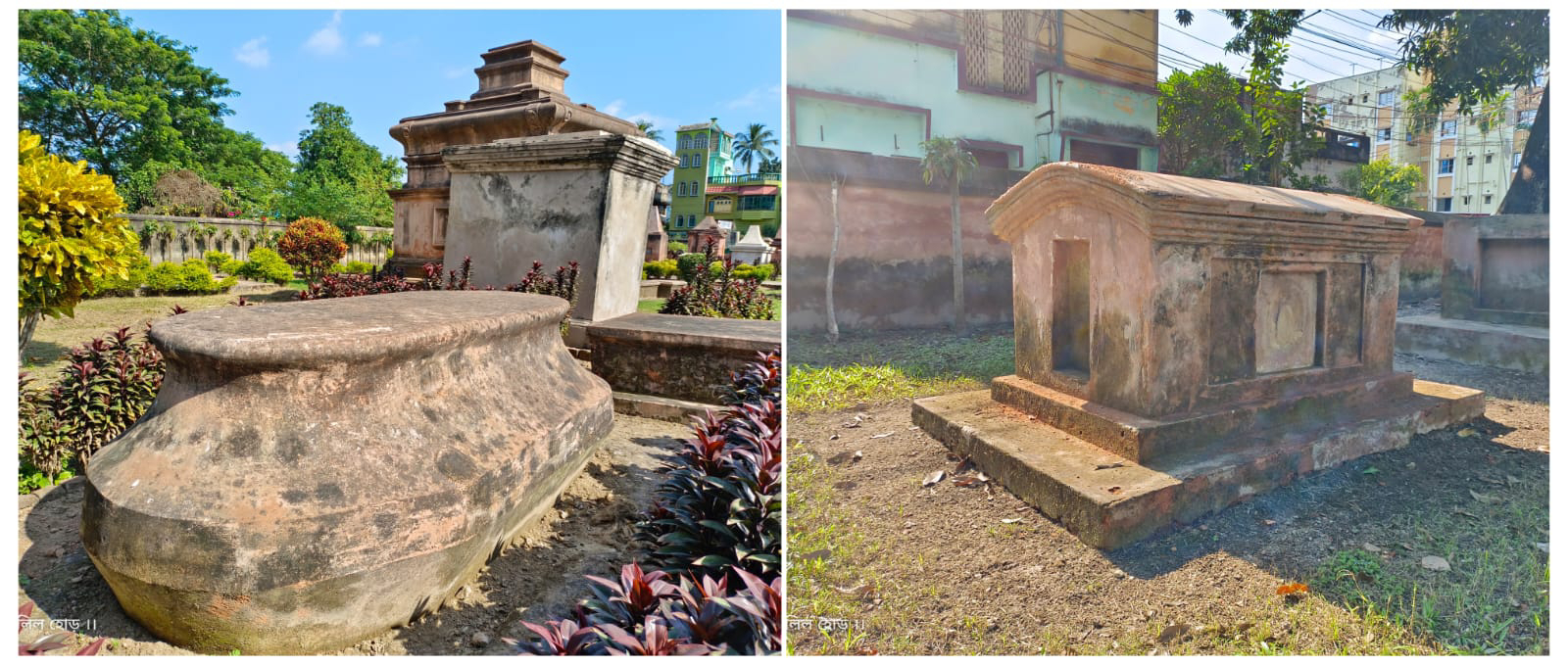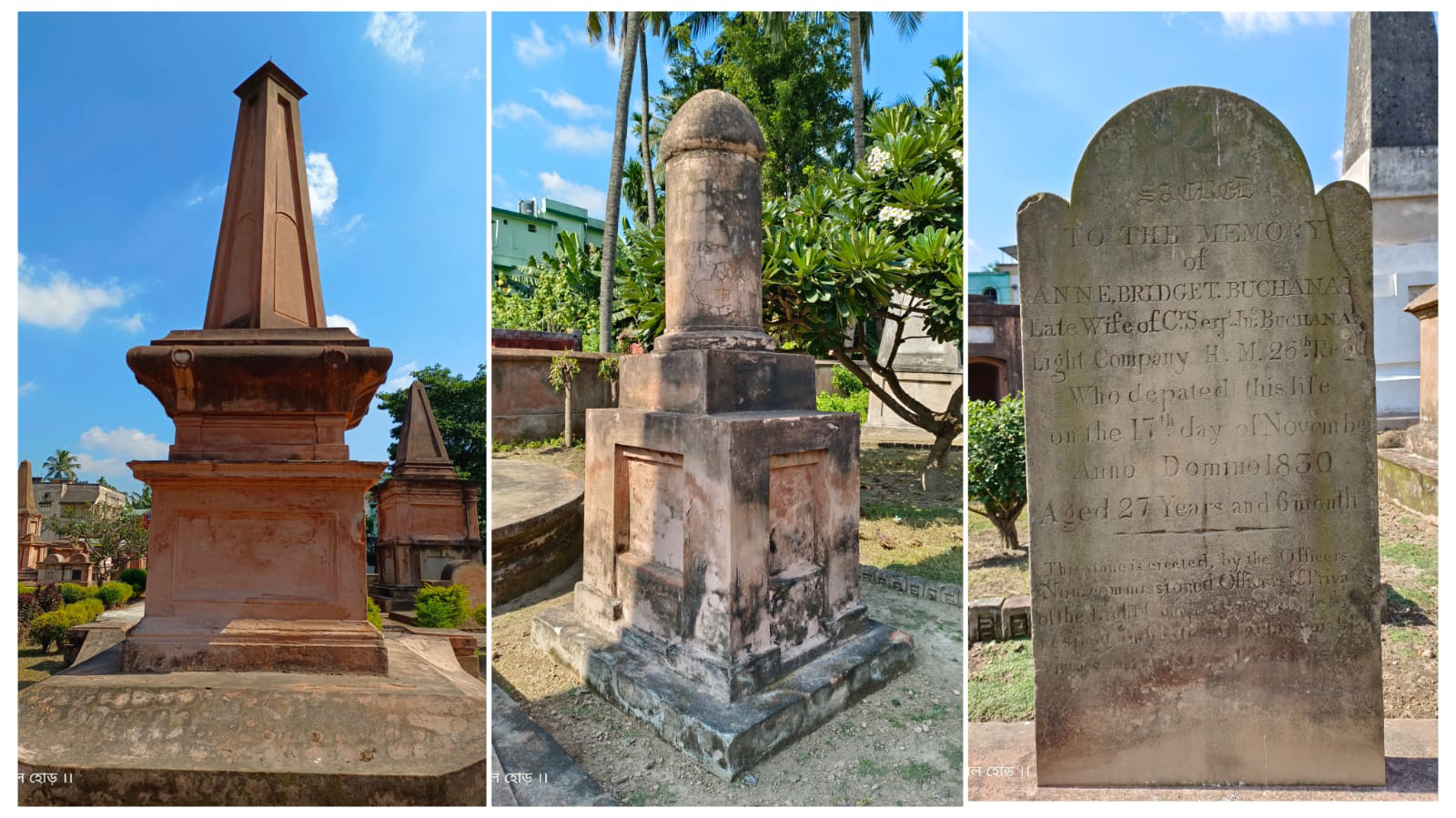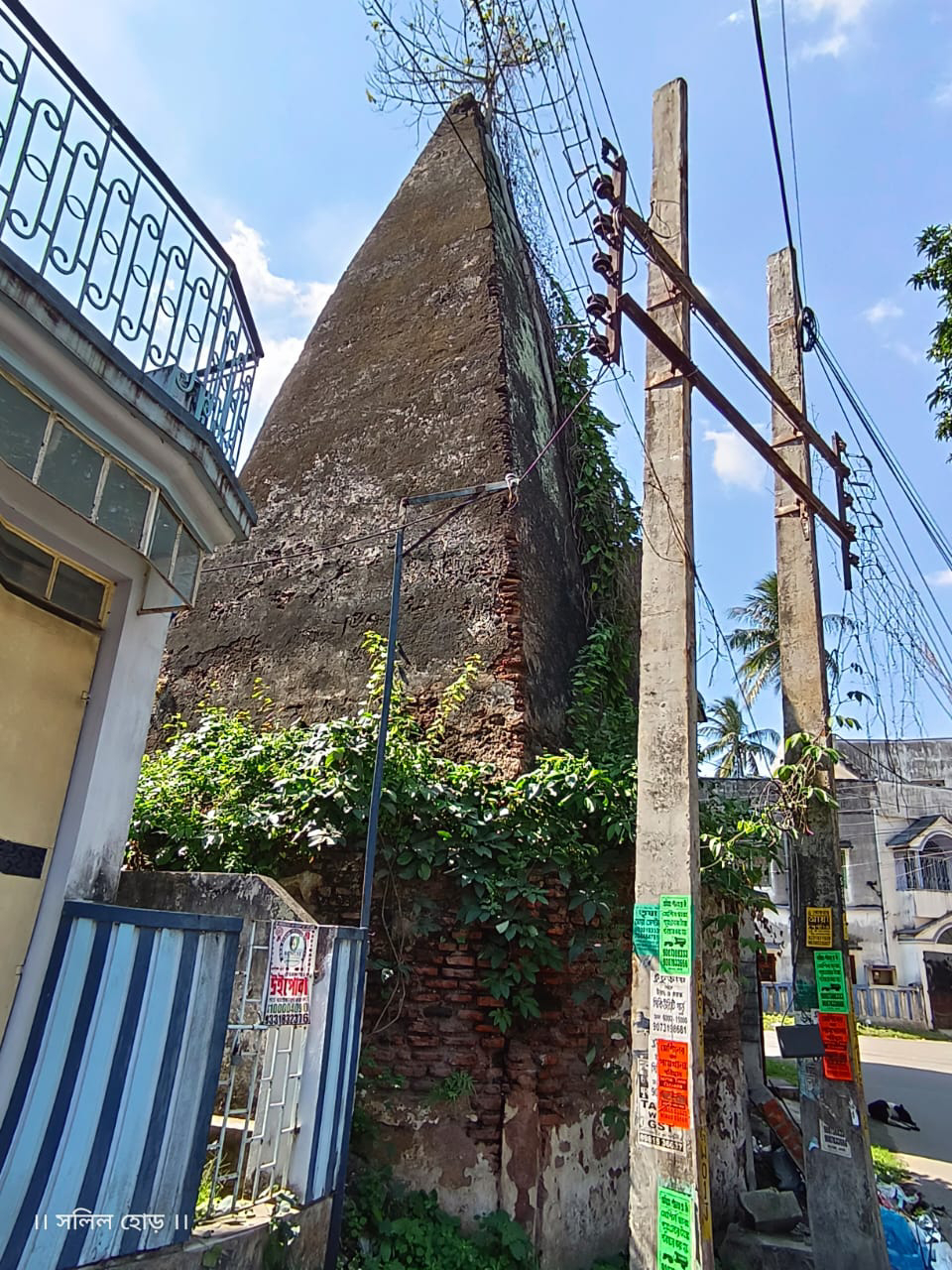ডাচ সমাধিস্থল চুঁচুড়া (Dutch Cemetery, Chinsurah)
সপ্তদশ শতকে বাংলা ছিল একটি গুরুত্বপূর্ণ ব্যাবসায়িক কেন্দ্র। সেই কারণে ইউরোপিয়ানদের আকর্ষণের কেন্দ্রবিন্দু হয়ে উঠেছিল আমাদের বাংলা। পোর্তুগিজরা প্রথমে বাংলায় আসে, আর তার পরেই আসে ওলন্দাজরা বা ডাচরা। সেই সূত্রে তারা পত্তন করে ডাচ ইস্ট ইন্ডিয়া কোম্পানি বা VOC (Vereenigde Ostindische Compagnie), এবং ১৬১৫ খ্রিস্টাব্দে তৎকালীন মুঘল সম্রাটের থেকে ভারতে ব্যাবসা করার অধিকার লাভ করে। ১৬৩৫ সালে তারা চিনসুরাতে (বর্তমানে চুঁচুড়া) বসতি স্থাপন করে; শুরু করে আফিম, সুতো, নুন, মশলা এবং নীলের ব্যাবসা। ১৬৫৬ খ্রিস্টাব্দে চুঁচুড়াতে একটা ডাচ কারখানা স্থাপিত হয়, যা ১৭৪০ খ্রিস্টাব্দে ঘিরে নিয়ে একটা দূর্গে রূপান্তরিত হয়। এর নাম দেওয়া হয় Fort Gustavus, যা ছিল তৎকালীন ডাচ গভর্নর জেনারেল Gustaaf Willem Van Imhoff এর নামে।
মোটামুটি ২০০ বছর (১৬১৫-১৮২৫ খ্রিস্টাব্দ) ডাচরা বাংলায় তাদের উপনিবেশ রেখেছিল। ১৮২৫ খ্রিস্টাব্দে ডাচ কমিশনার B.C.D. Bouman ইংরেজদের হাতে চুঁচুড়ার অধিকার সমর্পণ করেন। এরপরে ইংরেজরা এখানে ডাচ স্থাপত্যের অনেকটাই ভেঙে দিলেও, ডাচ কবরখানা বেঁচে যায় তাদের গ্রাস থেকে। আজকে এই কবরখানা নিয়েই আমরা আলোচনা করবো।
শহরের প্রথম ডাচ সমাধিক্ষেত্রটি প্রতিষ্ঠিত হয়েছিল ডাচ দূর্গটির মধ্যেই। পরবর্তীকালে সেটিকে শহরের একটা প্রান্তে (বর্তমানে ফুলপুকুর রোড এবং জ্যোতিষচন্দ্র সরণির সংযোগস্থলে) সরিয়ে দেওয়া হয়, এবং আজও সেটা ওখানেই রয়েছে। বর্তমানে সমাধিক্ষেত্রটির দুটো ভাগ, একটিতে এখনও সমাধি দেওয়া হয়। আর অন্যটি পুরনো অংশ, সেখানে আর সমাধি দেওয়া হয় না। এই অংশটি বর্তমানে আর ASI এর অধীনে। আমাদের আজকের আলোচনায় এই পুরনো ডাচ কবরখানাটি নিয়েই কথা বলবো।
আলোচ্য সমাধিক্ষেত্রটি পশ্চিমবঙ্গের সবথেকে বড় Non British European Cemetery, যার পরিধি প্রায় ৭৪০০ বর্গ মিটার। এখানে রয়েছে প্রায় ১৯০ টি সমাধি, যার মধ্যে কিছু রয়েছে ব্রিটিশদের... যারা ক্ষমতা হস্তান্তরের সময় এসেছিলেন চুঁচুড়া। এই সমাধিস্থলে প্রচুর ডাচ রাজকর্মচারীরা চিরনিদ্রায় রয়েছেন। শেষ ডাচ গভর্নর Daniel Overbeck (Died 1840 AD) এর সমাধি রয়েছে এখানে। এছাড়াও মেয়েদের এবং শিশুদের সমাধির সংখ্যাও কম নয়। সবথেকে প্রাচীন সমাধি এখানে রয়েছে Sir Cornelius Jonge এর, যার মৃত্যু হয়েছিল ১৭৪৩ খ্রিস্টাব্দে। তবে এই বিষয়ে একটা সন্দেহ আছে যে, ওনাকে প্রথমে পুরোনো দূর্গের কবরখানাতে সমাধিস্থ করা হয়েছিল, এবং ১৭৫৫ খ্রিস্টাব্দ নাগাদ এই নতুন সমাধিক্ষেত্র তৈরী হলে, এখানে ওনার সমাধিটি নিয়ে আসা হয়।
ডাচ সমাধিক্ষেত্রের সমাধিগুলো ভারতীয় এবং ডাচ স্থাপত্যরীতির সংমিশ্রণের এক অভূতপূর্ব উদাহরণ। বেশিরভাগ গম্বুজ, মিনার বা বাক্স আকৃতির; কফিন আকৃতির কয়েকটি সমাধি রয়েছে। আবার একটি প্রাচীন সমাধি বেশ বড়ো ঘরের মতো দেখতে। সমাধিক্ষেত্রটিতে বেশ কয়েকটি উঁচু মিনার আছে, যাদের উচ্চতা ২০-৩০ ফুট। মিনারগুলির কোনটির ভিত্তি ত্রিভুজের মতো, এবং তিনটি তল বরাবর উঁচু হয়ে উঠেছে। ভিত্তির চাতালটি তারা আকৃতির। আবার চারকোনা গম্বুজ আকৃতির, কোথাও থামের মত আকৃতি লক্ষ্য করা যায়। তবে অনেক সমাধির ফলকের লেখা এখন অস্পষ্ট, এবং অনেক লেখার অক্ষর ইংরাজি হলেও ভাষা ডাচ হওয়ার কারণে পঠনযোগ্য নয়। অনেক ক্ষেত্রে সাংকেতিক চিহ্ন দ্বারা বিভিন্ন বিষয় লেখা আছে, যেগুলি পাঠোদ্ধার সম্ভব হয়নি। একটি সমাধির ওপরে রয়েছে ডাচ রাজচিহ্ন, যেটি আমার বিশেষ দৃষ্টি আকর্ষণ করেছিল। উঁচু পাঁচিল দিয়ে ঘেরা সমাধিক্ষেত্রটির মধ্যে বেশ কয়েকটি বড় গাছ আছে। সম্ভবত কোনো কোনো সমাধির ইঁটের মিনার তৈরি না করে, তার বদলে বৃক্ষরোপণ করা হয়েছিল। যদিও ১৯৯৩ সালের এক ঘূর্ণিঝড়ে অনেক মিনার হেলে যায় এবং অনেক গাছ নষ্ট হয়ে যায়, যা পরবর্তীকালে ASI থেকে মেরামত করা হয়।
একটা সময়ে এই কবরখানার অবস্থা রক্ষণাবেক্ষণের অভাবে খুব খারাপ হয়ে গিয়েছিল। বর্তমানে ASI এর অধীনে এখানে সংরক্ষণের কাজ করা হয়েছে, এবং অনেক ফুলগাছ লাগিয়ে কবরখানার সৌন্দর্য্যবর্ধন করা হয়েছে।
এই প্রসঙ্গে একটি কথা না বললেই নয়। সমাধিক্ষেত্রটির চৌহদ্দির কিছুটা দূরে গেলে চোখে পড়ে চতুষ্কোণ পিরামিডের মত একটি সমাধিস্তম্ভ, যেটির ভিত্তি ১০০ বর্গফুটের মত হলেও উচ্চতা প্রায় ৩০ ফুট। ফলকবিহীন এই স্তম্ভটি চুন-সুরকি ও ইঁট দিয়ে তৈরি। বর্তমানে কয়েকটি বাড়ির ফাঁকে এটি জঙ্গলাকীর্ণ হয়ে রয়েছে। তবে অনেকের মতে এটি কোন সমাধি নয়, নদীপথে যাবার সময় রাস্তা নির্দেশক একটি চিহ্ন মাত্র।
তথ্যসূত্র:
১. Bengal District Gazetteers Hooghly-O'Malley, L.S.S.
২. Dutch in Chinsurah - A Digital Resource for Histories Between The 17th -19th Century in Chinsurah
৩. The Dutch in India & Chinsurah - by Oeendrila Lahiri
********************************
The Dutch Cemetery, Chinsurah: A Silent Testament to Bengal's Colonial Past
In the 17th century, Bengal emerged as a significant hub for trade, drawing the attention of European powers. Following the Portuguese, the Dutch arrived and established the Dutch East India Company (Vereenigde Ostindische Compagnie or VOC). By 1615, they secured trading rights from the Mughal emperor. In 1635, they established a settlement in Chinsurah (present-day Chuchura), engaging in the lucrative trade of opium, textiles, salt, spices, and indigo. A Dutch factory was established in Chinsurah in 1656, which was later fortified in 1740 and named Fort Gustavus, in honor of the then Dutch Governor-General Gustaaf Willem Van Imhoff.
For approximately two centuries (1615-1825), the Dutch maintained their presence in Bengal. However, in 1825, the Dutch commissioner B.C.D. Bouman ceded Chinsurah to the British. While the British dismantled much of the Dutch architecture, the Dutch Cemetery was spared. Today, this cemetery stands as a poignant reminder of this colonial era.
The city's first Dutch burial ground was located within the confines of Fort Gustavus. Later, it was relocated to the city's edge, at the intersection of Fulpukur Road and Jyotish Chandra Sarani, where it remains today. The present-day cemetery is divided into two sections: one still in use for burials and an older section where interments no longer take place. This older section is now under the care of the Archaeological Survey of India (ASI), and our discussion will focus on this historic part.
This cemetery is the largest non-British European cemetery in West Bengal, spanning approximately 7400 square meters. It houses around 190 tombs, including some of British individuals who arrived during the transfer of power. Many Dutch officials found their final resting place here, including the last Dutch Governor, Daniel Overbeck (died 1840 AD). The cemetery also holds a significant number of graves of women and children. The oldest identifiable tomb belongs to Sir Cornelius Jonge, who died in 1743 AD. However, it's speculated that he was initially buried in the old fort's cemetery and his remains were moved to the new cemetery around 1755.
The tombs within the Dutch Cemetery showcase a unique blend of Indian and Dutch architectural styles. Many are shaped like domes, minarets, or rectangular boxes, while some resemble coffins. One particularly old tomb has the appearance of a small room. Several towering minarets, reaching heights of 20-30 feet, dot the landscape. Some minarets have a triangular base rising through three tiers with a star-shaped platform, while others feature square domes or pillar-like structures. Unfortunately, inscriptions on many tombstones have faded, and while some are in English script, the Dutch language renders them unreadable. Symbolic markings on some graves remain undeciphered. Notably, one tomb bears the Dutch coat of arms, which particularly caught my attention. Enclosed by high walls, the cemetery also hosts several large trees, suggesting that in some instances, trees might have been planted in place of brick minarets. A cyclone in 1993 caused damage to several minarets and trees, which were subsequently repaired by the ASI.
Over time, the cemetery suffered from neglect. However, under the ASI's stewardship, conservation efforts have been undertaken, and numerous flowering plants have been added, enhancing the cemetery's beauty.
Interestingly, a short distance from the cemetery's boundary stands a quadrangular pyramid-like structure. With a base of approximately 100 square feet and a height of about 30 feet, this unadorned pillar is constructed of lime mortar and bricks. Currently nestled amidst a few houses and overgrown with vegetation, some believe it wasn't a tomb but rather a navigational marker for river travelers.
References:
* Bengal District Gazetteers Hooghly-O'Malley, L.S.S.
* Dutch in Chinsurah - A Digital Resource for Histories Between The 17th -19th Century in Chinsurah
* The Dutch in India & Chinsurah - by Oeendrila Lahiri













Comments
Post a Comment